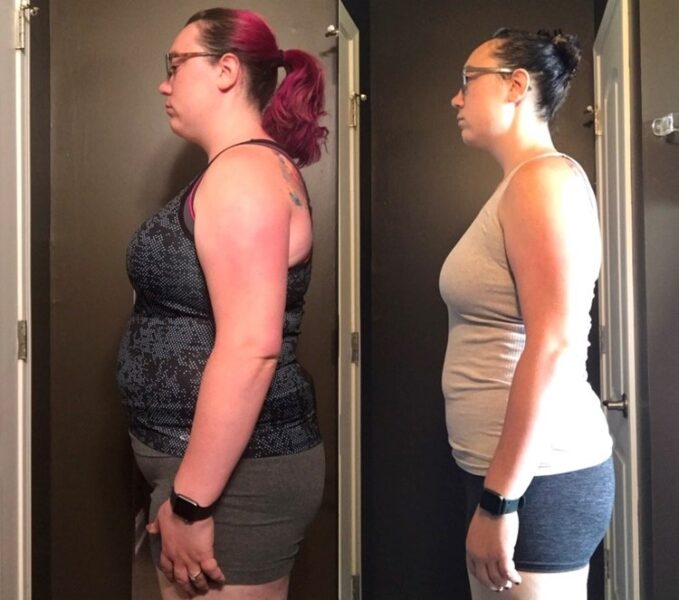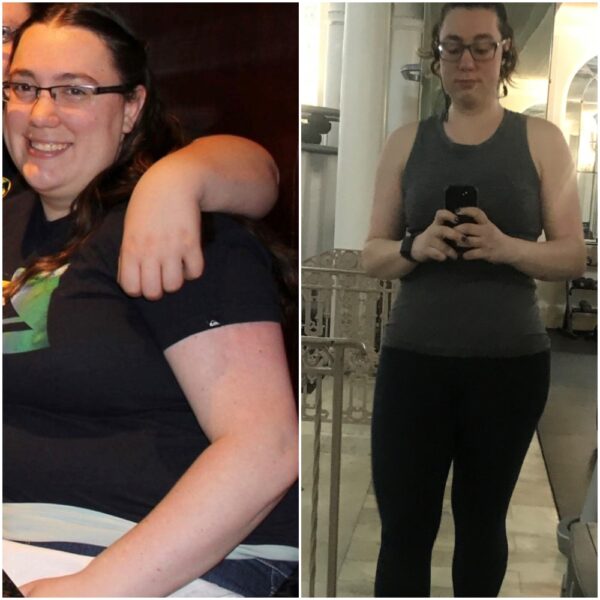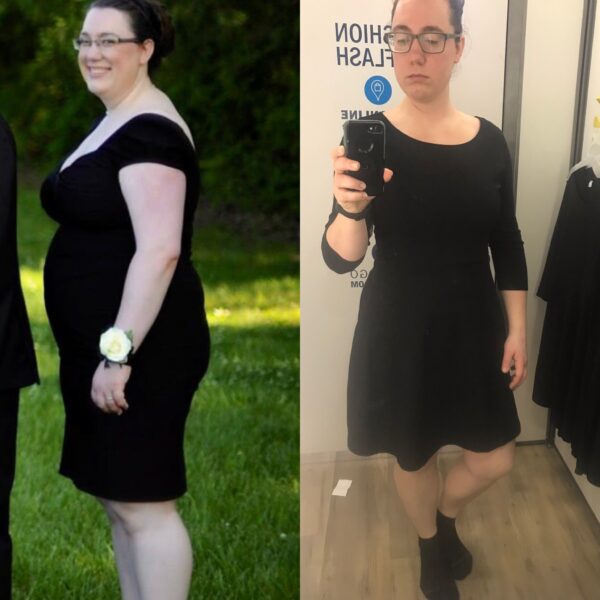Originally Posted At: https://breakingmuscle.com/feed/rss
The fitness industry is wrought with lies.
Originally Posted At: https://breakingmuscle.com/feed/rss
I love mountain sports. They energize, inspire, and motivate me—highly so. But sadly, I’ve become a regular patient at the orthopedic clinic. A renowned surgeon told me I need surgery on my right knee. As well as the left knee. And I trust the guy—yet, joint surgery is profoundly terrible. I know first-hand, I’ve been through it five times. Instead, I decided to see what I can do to stay active and put my back into knee cartilage regeneration through holistic and modern procedures and habits.
Originally posted at: http://www.nerdfitness.com/
“She is seriously crushing it.”
When you speak with Emily, it doesn’t take long to realize how proud she is of leveling up her life.
And she should be proud! What she’s accomplished is simply amazing.
Emily, a dog walker from Chicago, had been obese her entire adult life – and it wasn’t like she didn’t try to lose weight.
Emily had attempted:
Such start and stop patterns continued for years.
Then things changed.
Emily saw that Staci, our head female trainer for our 1-on-1 Online Coaching program, was accepting clients.
She knew it was time to try something different. And this time, things were different.
For starters, Emily, for the first time in her adult life, is no longer obese.
And when she heads to the gym, she crushes it, rocking 195 lb squats, 225 lb deadlifts, and 110 lb bench presses.
Awesome.
While all this is indeed super amazing, the thing I really want to highlight today is Emily’s mindset change.
Because she had tried getting in shape, multiple different ways, in the past.
However, a trap of “perfectionism” saw Emily abandoning all these earlier efforts.
But you don’t need to hear it from me. Let’s bring in Emily!
 Steve: Hi Emily! Thank you so much for taking the time to chat with me.
Steve: Hi Emily! Thank you so much for taking the time to chat with me.
I’d love to hear from you about your past – Can you take us through a typical day before you started your journey with Nerd Fitness?
Emily: A typical day for me looked something like this:
I did a lot of living in the moment. It really felt like I was trying so hard all the time, but a lack of planning ahead gave me too many opportunities to slip up.
Steve: Yeah, marketers really do place junk food at every angle in our grocery stores. It really is tough to avoid it all.
Was this the first time you had tried to get in shape?
Emily: Hardly.
I’d tried sticking to 1,200 calories a day for weight loss but just couldn’t do it. I ended up hungry and grouchy a lot.

Later, I tried again and bumped it up to 1,500 calories a day. Same results though, I ended up miserably and abandoned the effort.
As far as working out, I could never achieve consistency. There would be times when I wouldn’t even try and exercise. Other times, I’d try and work out every day. But I never felt good about what I was doing.
I gave the P90x and TurboFire programs a shot, but they were too tough for me.
I tried some Jillian Michaels videos but got bored.
I joined Planet Fitness, but it turns out I hate treadmills and elliptical machines with the fire of 1,000 suns. I tried their weight machines too, but it felt really awkward.
Going through all this has taught me a valuable lesson: if you don’t like what you’re doing, you probably won’t continue to do it.
Steve: You’re 100% right! We often tell people to exercise in a way they love and to do that as much as possible. That, and also strength training.
But since you’re working with Coach Staci, I’m sure we’ll get to more of that soon.
Was there a specific moment when you decided to ask for help?
 Emily: There was.
Emily: There was.
I had just hit my highest weight ever. I was on the couch crying, looking through the subreddit r/progresspics (where people post before and after photos), and I was so frustrated.
I felt like I was constantly trying to lose weight, making lots of good choices while still getting nowhere. I had been a member of the Nerd Fitness Academy for a while and had leveled up a lot of my choices, but the weight loss just wasn’t happening.
Then, I saw that Staci was accepting clients for 1-on-1 Coaching, and decided to sign up.
Which has been a game changer.
In the past, I had a tendency to pick a shiny new program, try hard to be perfect, fail and burn out, and give up for a while until I found another shiny new program.
Staci really helped me focus, pick myself back up when I fell, and keep going.
Steve: I’m so happy to hear you hit it off with Staci.
Can we talk a little bit more about your “perfectionism?” I think jumping from one program to the next is something a lot of people can relate to.
Emily: Yeah, my perfectionism was really holding me back.
I used to set ridiculously impossible goals. I’d do okay for a bit, then I’d have an eff it moment and eat half a package of Oreos. From there I’d spend the next two weeks spiraling in shame and frustration, wondering why I can never seem to stay on track.
Then I’d vow to get “back on the wagon” and the cycle would begin all over again.
I had to start where I was and learn to set teeny tiny incremental goals. Goals that I could still do even when everything felt impossibly hard. Goals like:
I had been trying to jump into a healthy lifestyle with both feet, when what I really needed was to baby-step my way there.

So looking back, the most important change I’ve made is focusing on consistency over perfection:
It doesn’t matter if my food log isn’t absolutely flawless, just that I log all my food as best I can each day.
It doesn’t matter that every workout isn’t the most incredibly hard-core workout ever, just that I actually get myself to the gym three times per week.
Keeping myself moving forward even when I feel like giving up is the absolute most important thing.
Steve: Yes! You nailed two key points: Often it’s easier to make small habits you can stick with instead of changing every single aspect of your life all at once.
The other is that consistency is the name of the game. No one is perfect, but a key characteristic of success is to keep going. Your response highlighted both ideas perfectly.
What’s your workout program look like? What is Coach Staci having you do?
 Emily: Strength training.
Emily: Strength training.
I lift weights on Tuesday, Thursday, and Sunday mornings first thing.
I also go to yoga class on Monday after work.
I LOVE lifting, it makes me feel like such a badass. Once I picked up a barbell for the first time, I was like “Okay, this is it. I found my favorite thing to do.”
I’ve gone from basically just lifting the bar to a 195 lb squat, a 225 lb deadlift, and a 110 lb bench.
Steve: I don’t know if you can fully understand how happy you just made me! I’m so pumped that Staci helped you find a love of strength training.
Talk to me a little bit about nutrition. What have you done differently? What strategy are you following?
Emily: Since I was constantly hungry when cutting calories before, we knew we had to keep my volume up. Which meant eating vegetables to meet my calorie goals.
But I was convinced I didn’t like veggies. However, I decided to start an experiment. Every week I would pick up a vegetable I thought I didn’t like, and try cooking it a few different ways. If at the end of the week I still didn’t like it, that’s fine. I wouldn’t buy it again.
The thing is, I found I actually DID like a bunch of different veggies. I just didn’t like the kind forced on me as a kid: boiled to death and soggy with no seasoning.

Another thing that helped was making a food plan ahead of time. Planning helped me restructure my life and make the healthier choice easier, and the less healthy choice harder.
For example: let’s say it’s Thursday evening after work. I had a hard day and I’m hungry, grumpy, and tired. I know that I’ll make the easiest choice available at the moment:
Emily With No Plan hasn’t thought ahead, as though it’s a surprise that she has to feed herself every day. She could either figure out a healthy meal to make, probably have to swing by the grocery store and pick up ingredients, come home, prep everything and cook. Or, she could order delivery. Honestly, she’s probably going to order delivery.
Emily With A Plan is prepared! She previously decided that dinner is chicken fajitas. There’s chicken thawing in the fridge and the veggies are washed, chopped, and ready to go. In the moment there’s no tough decision to make. Plus, it’s faster to just make the fajitas. She’s probably not ordering delivery.
I’ve used this strategy a lot.
I ate a ton of chips, so I stopped buying them. When I wanted them I would have to go to the store and buy a single serving. That’s a lot of work for like 10 potato chips.
I ate a lot of cookies too, so I decided “I no longer keep store-bought cookies in the house.”
If I want them I have to make them from scratch. I’ve actually made them only a handful of times since implementing this rule, which has drastically reduced my cookie consumption. Shifting the regular structures of my life in this way has allowed me to use my laziness as an advantage. If I make unhealthy choices too much work, I’m WAY less likely to choose them.
Steve: That’s incredible. I made that same exact point in a recent article, “Super Simple Batch Cooked Chicken For Lazy People.” You really distilled down the argument on your example of fajitas.
Also, your strategy on learning to like veggies is the exact one I used! Great work all around.
What’s a typical day for you like now?
Emily: A typical day for me now:
Planning ahead and setting up healthy habits has helped me so much:
I don’t have to decide what’s for lunch or dinner, because that decision was already made.
I don’t have to white knuckle my way past junk food at the grocery store while picking up dinner ingredients because they’re already in the fridge.
I don’t have to decide to work out, because gym time is blocked out on my calendar. If it’s time to go to the gym, I just go.
No decision, no skipping because I don’t want to, no internal drama. Just go. That also means when it’s not gym time, I don’t have to think about it or feel guilty that’s it’s been too long since I last worked out. I’ve set up the structure of my life to support healthy habits and remove opportunities for unhealthy behaviors.

Steve: You really are crushing it Emily. Both you and Coach Staci should be very proud.
Your appearance has changed? What else has changed about you?
Emily: I have completely changed.
You’re right, how I look has obviously changed, but I’m also way more confident now.
I’ve proven to myself that I can do what I once thought was impossible. I can look my flaws square in the face and learn from them instead of running from them.
I can rebuild my life from the ground up. I’m more assertive now instead of letting people walk all over me like I used to do. I’m way more energetic than I ever was before. And I’m more social because I have the energy to go out and do stuff.
I’m like an entirely different person.

Steve: I’m so happy to hear that. We often talk about how one improvement in life can lead to another, and then another, creating a chain reaction.
I’m so happy you feel more confident as a result of your new habits.
Okay, real talk: NF Coaching isn’t cheap. You’ve been a client for a year and a half. What makes you stick with it and keep investing in yourself?
Emily: Coaching has definitely been worth the investment.
Just knowing Staci is there in my back pocket, that she believes unequivocally I can do it, and she’s there with me every step of the way has been invaluable.
She keeps me grounded and focused. She keeps me from getting distracted by shiny new programs. And when things get rough and I start to get overwhelmed, she helps me keep things in perspective and just keep trucking along.
Interestingly enough, I’m actually better off financially now than I was before Coaching.

Managing my calorie budget has helped me with my financial budget – there’s a ton of overlap. It’s helped me hone my long-term planning skills.
Practicing the skill of not eating junk food even though I want it has helped me sharpen my ability to not buy things I don’t need. Both require trying to get the most out of limited resources. Both require putting long term goals before short term desires.
Steve: I totally believe it. The financial and calorie budget analogy and overlap makes a lot of sense to me. You’re a clever one, Emily, and you’re okay in my book!
Alright, I’ve got to ask: do you have any nerdy passions or pursuits?
Emily: I read a ton of fantasy and sci-fi. My favorites are Name of the Wind, The Lies of Locke Lamora, and Way of Kings. I’m in three book clubs. I also love playing board games.
I consider myself a Trekkie, but have also cosplayed as Kaylee from Firefly.
Lastly, I just started playing D&D for the first time – my character is a kick-butt Druid.

Steve: A love of fantasy and sci-fi, cosplaying experience, and repping a D&D character: your nerd credentials are in proper order. We may proceed.
What’s next for you Emily? Where do you go from here?
Emily: Two main goals:
Steve: I have no doubt you will rock a chin-up soon. You’ve been crushing everything else you’ve sought after.
Best of luck Emily! And thanks again for taking the time to share your story with all of us!

We can all learn a lot from Emily.
Losing weight and transforming yourself is tough. When someone around us does it, it’s worth analyzing their behavior to see if any lessons can be gleaned for the rest of us. Something we can ponder, and then take action with ourselves.
Emily’s journey provides plenty of good examples. In speaking with her, I distilled six key traits that set her apart. Six behaviors that helped Emily succeed despite the odds against.
Here’s what we can learn from Emily:
#1) EMILY DIDN’T GIVE UP
 Emily had been trying to lose weight for years:
Emily had been trying to lose weight for years:
Restricting caloric intake to super low levels? Check.
Running mindlessly on treadmills? Check.
At home workout videos? Double check.
She tried all of it. And she didn’t like ANY of it.
So she’d move onto the next “shiny new program.”
What’s important is Emily never gave up. She kept trying new things.
Then, when she started working with Nerd Fitness Coaching, she tried something different: picking up a barbell.
Now, Emily loves strength training and feels like a badass for doing it.
There’s no ONE way to get in shape, and Emily finally found something she loves and will stick with.
The important thing is Emily kept trying until she got it right. Speaking of…
#2) EMILY IS WILLING TO EXPERIMENT
 I love Emily’s willingness to experiment with vegetables.
I love Emily’s willingness to experiment with vegetables.
Vegetables are nutrient dense, full of fiber, and low on calories.
If you’re trying to eat within your calorie goals, but don’t want to be “hungry and grouchy” the whole time, vegetables will be key.
Emily was convinced she didn’t like vegetables. But she decided to test her assumptions and try some out. She did this by picking out one new veggie a week.
If she cooked it and hated it, no big deal. She wouldn’t force herself to eat it again. But if she liked it…BOOM! A new vegetable could be added to the menu.
Emily discovered she liked many different kinds of vegetables, as long as they were prepared correctly.
Be open to experimentation. Try new things. Not everything you experiment with has to work. But some things you try just might.
#3) EMILY BUILT A SYSTEM AND HAS A PLAN
One of the true gems of Emily’s interview comes from the “Emily With No Plan” and “Emily With A Plan” comparison.
She really nailed it. When you have a plan, like prepared meals for the week, you take all the guesswork out of “what should I eat?” Dinner time, which comes around every day, doesn’t have to be a surprise.

Emily knows exactly what to eat because she planned it out over the weekend. And she never has to stress about not having supplies, because she picked those up too over the weekend.
When it comes time to figure out what to eat, the easiest option available to Emily is the healthy meal she has planned for.
The same strategy can be seen on her workout schedule:
Tuesday morning? She’s up early crushing it at the gym.
Wednesday morning? She’s sleeping in.
Emily never feels guilty about waking up late, because it’s all part of her plan. Wednesday’s are her day to rest. The gym will be calling tomorrow.
Make a plan. Put it on your calendar. Make your healthy habits automatic instead of worrying about what to do from one moment to the next.
#4) EMILY DIDN’T LET PERFECT BE THE ENEMY OF GOOD
In the past, Emily had let “perfectionism” derail her efforts.
In her own words, Emily would find a “shiny new program.” She’d go all in, excited about her new endeavor.
Then…life would happen. She’d miss a workout. She’d eat some Oreos. She’d order takeout.
When this would inevitably happen, she’d have an “eff it” moment. Emily would abandon everything and “then spend two weeks spiraling in shame and frustration.”
Then, she’d try again, have another “eff it” moment and the cycle would repeat.
But not anymore.
Today, Emily is consistent. If she wants to have some cookies, it’s okay! She knows tomorrow it’s back to strength training and the chicken fajitas she has ready to cook.
No one is perfect. We all have moments where we stray from the path. The important thing is to not let one decision affect all future decisions:
Don’t let some potato chips today stop you from going to your yoga class.
Don’t let sleeping in and missing a workout this morning stop you from cooking dinner tonight.
Don’t let “perfect” be the enemy of “good.”

#5) EMILY INVESTED IN HERSELF AND ASKED FOR HELP
Emily had tried to get in shape many times before.
And Emily had stopped trying just as many times.
When Emily saw that Staci was accepting clients as part of NF Coaching, she decided to try again. But this time, she would ask for help.
It’s okay to ask for help. Even if you have to invest your time or money to do so.
You are not the first person to want to get in shape. Emily is not the first Rebel to transform herself. What makes them successful varies from person to person, but oftentimes it’s that they reached out for assistance.
It’s okay to ask someone for guidance. Someone who has helped others do exactly what you want to do.
Yes, you will most likely have to pay for this expertise. But oftentimes, it is indeed worth every penny.
I’ve personally had an online coach for 4 years, someone who knows exactly how to help me reach my goals, and it’s the best investment I’ve ever made.
Remember, you don’t have to make this journey alone.

#6) EMILY IS HAVING FUN ALONG THE WAY
I know it’s cliché, but getting in shape really is a lifestyle adjustment. Meaning this isn’t something you do for a week, a month, or even one year.
It’s something you will do for the rest of your life.
For this to work, you need to enjoy the journey ahead.
And Emily is enjoying herself!
She feels like a total badass when she deadlifts. And she should, because doing deadlifts is badass.
Emily doesn’t dread picking up the barbell. She looks forward to it.
That means she’ll keep doing it!
Emily takes a yoga class because Emily likes taking yoga classes.
Emily makes chicken fajitas because Emily likes chicken fajitas.
Emily occasionally makes homemade cookies, because occasionally Emily likes making homemade cookies.
You need to enjoy what you do, otherwise, you won’t stick with it. You need to have fun today, so years from now you’ll still be doing it.
It’s a message I really push in the video “Want to get in shape? Think in days and years, not weeks and months”
We are not making temporary changes, because they will only create temporary results. We are making permanent changes, so our transformations will be permanent.

I’m super proud of what Emily and Coach Staci have accomplished.
And if you’re still reading this, I want you to know I’m proud of you too.
You’re still reading, which means you’re still trying (see #1). You found your way to our strange corner of the internet and you’re part of the Rebellion.
I’m so happy you’re here today.
We’ll continue to be here for you tomorrow, next month, and years from now.
No matter where you are on your journey, I would encourage you to think about what made Emily successful:
If you found yourself relating to Emily’s story, jumping from “shiny new program” to “shiny new program” without getting the results you’re after, maybe it’s time for something different.
Depending on your current situation, our 1-on-1 NF Coaching Program might be the droids solution you’re looking for. You can learn more by clicking on the box below and scheduling a call with our team!
No matter what you do, here’s what I want you to take away from Emily’s story:
If you do those two things, I can almost guarantee you’ll be a healthier version of you in 12 months. Then maybe it’ll be your story on the website we’ll be sharing. And hey, maybe your journey will inspire change in someone else!
-Steve
PS: I want to give a special shoutout to Coach Staci, who helped turn Emily’s life around. Staci has guided and inspired hundreds if not thousands of Rebels and we are very lucky to have her on Team Nerd Fitness.
If you want to see if we can help you level up your life, check out our 1-on-1 Coaching program. We’d love to talk to you, no matter what you end up deciding.
http://chriskresser.com/

The viruses that cause a cold or the flu lurk at work, school, daycare, and everywhere in between. And even if you yourself manage to stay virus free, there’s a high chance a family member or partner will bring a bug home. In the United States, the season is roughly fall and winter, peaking between December and February—but it can last until May.
Should you happen to catch a cold or the flu, you don’t have to turn to drugs and OTC medications to avoid the misery of nasal congestion, sore throat, coughing, fever, and just feeling wiped out. Read on to learn 20 natural remedies for the cold and flu that can significantly boost your immunity and shorten the duration of illness, so you can get back to feeling your best.
Upper respiratory illnesses take a considerable toll on the American population. According to CDC estimates, Americans suffer approximately 30 million cases of the flu per year. (1) On top of that, American adults experience two to three colds per year and children even more—somewhere in the range of six to eight per year is a conservative estimate. (2) While both illnesses are unpleasant, there are some important differences between a cold and the flu.
You don’t need to suffer through cold and flu season, and you don’t need to turn to over-the-counter solutions to feel better. Check out this article for my top 20 natural remedies to ease symptoms and shorten your illness. #healthylifestyle #wellness #chriskresser
A cold is an acute, self-limiting viral infection of the upper respiratory tract. Colds can be caused by more than 200 different viruses, with coronaviruses and rhinoviruses the most frequent culprits. (3) The sheer number of cold-causing viruses in existence means that the body has a hard time building up resistance to them—this is why we have yet to develop a “cure” for the common cold! The common cold spreads through hand contact with an infected person, by touching a contaminated object they’ve handled, or by encountering aerosolized droplets released during a sneeze or cough.
The flu, on the other hand, is a contagious viral respiratory infection that causes mild to severe illness. (4) There are four types of influenza viruses: A, B, C, and D. Humans are primarily affected by influenza viruses A and B—these viruses are responsible for seasonal epidemics of the flu each winter. Type C causes a very mild respiratory illness, and type D infects cattle, so these two are significantly less worrisome.
Like the common cold, the flu is spread by virus-laden airborne droplets when infected people cough, sneeze, or talk. Less often, a person may contract the flu by touching a surface or object that harbors the flu virus and then touching their own mouth, nose, or eyes.
The flu vaccine (or nasal spray) is available in doctors’ offices, drugstore chains, grocery stores, and even drive-through clinics. However, a growing body of research indicates that it may not always be as effective as we’ve been led to believe. Perhaps even more importantly, the flu vaccine may have some adverse health consequences. (5)
A flu vaccine “effective” in one season may increase your risk of developing the flu in a subsequent season. This effect is due to a process called “antibody-dependent enhancement,” which occurs when virus–antibody complexes adapt and find alternate ways into cells, typically after a person receives the vaccine. (6) Getting the flu vaccine may also blunt the effectiveness of subsequent vaccines and increase the chance that you will infect others. (7, 8)
The efficacy of the flu vaccine is also up for debate. Three large scientific reviews have noted only “a modest effect” of the influenza vaccine on reducing flu symptoms in children, adults, and the elderly. (9, 10, 11) In addition, a large part of the purported benefit of flu vaccines may be due to the “healthy-user bias,” a phenomenon in which the subjects that voluntarily enroll in a trial (such as to receive a flu vaccine) are, on average, healthier than the general population—meaning that they are less likely to get sick in the first place, thus exaggerating the vaccine’s preventive advantages in study results.
Last but not least, conflicts of interest abound in vaccine research. The authors of the reviews mentioned above noted that industry-funded studies were significantly more likely to report conclusions in favor of vaccines than publicly funded studies. Furthermore, they reported:
The review[s] showed that reliable evidence on influenza vaccines is thin, but there is evidence of widespread manipulation of conclusions and spurious notoriety of the studies. (12)
While for many of us the flu is a temporary (albeit uncomfortable) problem, there are certain populations who are more at risk for serious complications related to the illness and may benefit from receiving the flu shot. Healthcare workers with direct patient contact may benefit from the vaccine, as they are in frequent contact with sick patients who may be carrying the flu virus. (13) Asthmatics may also benefit, since viral respiratory infections take a greater toll on their health than that of the average non-asthmatic individual. (14) Finally, the flu vaccine may also be valuable for immunocompromised and elderly people because in these populations, the flu can lead to serious and potentially life-threatening conditions such as bacterial pneumonia and respiratory failure. (15, 16)
When many people feel the first signs of a cold or the flu, they begin popping over-the-counter pharmaceuticals such as decongestants, antihistamines, and non-steroidal anti-inflammatory drugs (NSAIDs), like ibuprofen and aspirin. However, evidence indicates that these drugs do nothing to shorten the duration of illness or prevent illness in the first place; they merely suppress symptoms. (17) Furthermore, many of these drugs come with significant side effects. See my article “How Safe Is Your Over-the-Counter Medicine?” to learn more about the health risks associated with these drugs.
A surprising number of physicians still prescribe antibiotics to patients with cold and flu symptoms, even though it’s well known that antibiotics—intended to prevent or kill bacterial infections—are completely useless for treating viral infections. According to recent statistics, a shocking 25 percent of antibiotics are inappropriately prescribed, and an additional 35 percent of prescriptions are “potentially inappropriate.” Many of these inappropriate prescriptions are given to patients (often children) with upper respiratory infections, sinusitis, and sore throats, which are most frequently viral in nature and not caused by bacteria. (18)
The indiscriminate prescribing of antibiotics is one of the primary reasons why antibiotic resistance has become such a pressing problem in our society. To stem the tide of antibiotic resistance, we need to significantly reduce our use of antibiotics, especially in cases where they aren’t even useful, such as in the treatment of colds and flu.
It’s not just bacteria that are becoming resistant to pharmaceutical drugs; viruses are also developing drug resistance. Recent research has revealed that the influenza A virus, the virus responsible for seasonal epidemics of the flu, can quickly acquire resistance to anti-influenza drugs by mutating viral components. (19) This poses a problem for the conventional medical system, which relies on antiviral drugs to treat severe flu cases.
We can promote recovery when we catch a cold or the flu, and even prevent it from taking hold, without relying on drugs—because nature has provided us with an abundance of botanicals, vitamins, and minerals that boost our immunity and even attack the cold and flu viruses, thereby both reducing symptoms and shortening the duration of illness.
Andrographis (Andrographis paniculata) is an herbaceous plant native to India and Sri Lanka. It is a primary herb for the treatment of fever and infectious illnesses in both traditional Chinese medicine and Ayurvedic medicine.
The antimicrobial and immune-enhancing properties of andrographis have garnered significant scientific attention, and research has shown that this botanical is a powerful ally in the treatment of colds and flu. When taken within the first 36 to 48 hours of illness, andrographis can significantly reduce the severity and duration of upper respiratory infections. (20) Andrographolide, a primary compound derived from andrographis, may also inhibit influenza virus replication and reduce virus-induced inflammation, the cause of multiple flu symptoms such as fatigue and muscle soreness. (21, 22) In fact, these beneficial properties have made andrographis a popular remedy in Europe for the treatment of influenza. (23)
Because the available research on andrographis is variable in terms of extracts and dosages used, it is difficult to determine the optimal dosage for treating colds and flu. (24) However, the lower end of the dosage range used in clinical trials is 400 mg of andrographis (standardized for andrographolide content) three times per day, and the upper end is 1,000 to 2,000 mg three times per day. Andrographis at these dosages is intended for short-term use.
Honey promotes recovery from viral respiratory infections. Manuka honey, a type of honey produced by bees that feed on the nectar of the New Zealand tea tree, inhibits flu virus replication. (It also boosts the effectiveness of certain antiviral drugs used for the treatment of influenza—the prescription drug Tamiflu is one example.) (25, 26) Honey has also been shown to be more effective than dextromethorphan and diphenhydramine, the most common active ingredients in OTC cough medicines, at improving nightly cough and sleep quality in children with upper respiratory infections. (27)
Methylglyoxal (MGO) is the primary anti-influenza ingredient in Manuka honey. When selecting Manuka honey for medicinal uses, look for the “MGO” label on the jar—it should state a minimum MGO content of 83. The higher the MGO rating, the higher the level of antiviral activity of the honey.
Propolis is a resinous mixture produced when bees mix their saliva and beeswax with secretions gathered from tree buds and other botanical sources. Bees use propolis to protect their community from bacterial, fungal, and viral pathogens, essentially making propolis the “immune system” of the hive. It turns out that the “immune system” of the beehive also benefits the human immune system. Propolis contains polyphenolic compounds with anti-influenza activity and, when administered nasally, may significantly accelerate recovery from the common cold. (28, 29)
To accelerate recovery from colds and flu, begin with one tablespoon of high-MGO Manuka honey per day. Complement this with a propolis throat spray, such as this one by Beekeeper’s Naturals.
Bovine colostrum is the first milk produced a cow following the birth of a calf. It has a similar structure to human colostrum and proffers comparable immune-boosting benefits. In fact, bovine colostrum has been found to be three times more effective at preventing the flu than the flu vaccine and significantly reduces the number of episodes and hospitalizations for respiratory infections in children. (30, 31) You can purchase bovine colostrum as a powder or capsule; just choose a supplement from grass-fed, hormone-free, and antibiotic-free cows to ensure that you are getting the healthiest product possible.
Chinese skullcap (Scutellaria baicalensis) is an antiviral that’s often effective against drug-resistant and nonresistant strains of influenza and cold-causing viruses. (32, 33) It’s been shown to stop viruses from reproducing, inhibit proteins present on influenza viruses that facilitate their adhesion to cells, suppress viral gene expression, protect cell membranes from virus-associated inflammation, and boost immunity.
The root extract of Chinese skullcap can be taken for colds and flu in tincture form at a dose of one-fourth to one-half teaspoon three times daily or as one teaspoon of powdered root three to six times a day. Chinese skullcap should not be taken during pregnancy and should be used with caution if you are taking any medications because it can increase the bioavailability of the drugs, intensifying their effects on the body.
Echinacea refers to a group of herbaceous flowering plants in the daisy family native to Eastern and Central North America. Historically, Native Americans used echinacea to treat severe infections; today, the anti-infective properties of echinacea have been demonstrated by several clinical trials.
In one trial, 755 subjects were given either Echinacea purpurea or placebo for four months; those in the echinacea group experienced a significantly reduced occurrence of virally confirmed cold episodes. (34) A second clinical trial found echinacea to be as effective as the antiviral drug oseltamivir (Tamiflu) for the early treatment of influenza virus infections. However, unlike oseltamivir, echinacea does not run the risk of inducing antiviral drug resistance. (35)
Echinacea can be consumed as a tea or tincture or in capsules. If you take echinacea in a liquid form (tea or tincture), retain the dose in your mouth for approximately 10 seconds before swallowing to boost the local antiviral effects on oral tissues. (36)
The small, dark purple berries of the elderberry plant have a long history of use for the treatment of colds and flu. Elderberry extracts alleviate cold and flu symptoms and can significantly shorten the duration of illness by two to four days. (37, 38) Elderberry may battle cold and flu viruses by increasing serum antioxidant capacity.
Elderberry syrup is a time-honored and palatable method for consuming elderberry and can be taken in a dosage of 15 mL four times a day until cold and flu symptoms abate. Elderberry lozenges are another option that also frequently contain other immune-supportive ingredients, such as zinc. Elderberry is safe to consume during pregnancy and has no known drug interactions.
The humble garlic bulb has quite a colorful history—in medieval times, garlic was worn on the body to ward off the “evil eye” and hung in homes to protect against supernatural entities believed to cause illness. Today, it has become clear that these superstitions held a grain of truth; while garlic may not ward off the evil eye or malicious spirits (or vampires), it does help to protect against disease-causing agents, including viruses.
Allicin, a compound released when a garlic clove is crushed, smashed, or chopped, has been shown to boost immunity against cold-causing viruses. (39) Aged garlic extract, a preparation that lacks the pungent scent of fresh garlic, may reduce cold and flu severity by enhancing the function of immune cells and reducing virus-induced inflammation. (40, 41)
The dose of aged garlic extract used in clinical trials for colds and flu is approximately 2.5 g per day. The optimal dosages of fresh and dried garlic for colds and flu have not been determined, but clinical trials examining the broad-spectrum antimicrobial properties of garlic have used dosages between 600 and 1,200 mg per day.
In China and Japan, ginger is a key supportive ingredient in traditional herbal formulas for treating the common cold. Scientific research indicates that fresh ginger may have antiviral activity against certain viruses that infect the respiratory system. (42)
To get the maximum antiviral benefits of ginger, I recommend making the following ginger tea recipe:
Houttuynia cordata is a traditional Chinese herb active against multiple respiratory viruses, including influenza. It can be taken in a tincture or as a powdered dry herb. For viral respiratory infections, the recommended dose of tincture is one-fourth to one-half teaspoon six times per day or one-half teaspoon three to six times daily for the dried herb.
Licorice root (Glycyrrhiza glabra) is a botanical medicine with broad-spectrum antiviral properties. Glycyrrhizin, the sweet-tasting constituent of licorice root, can inhibit the replication of influenza virus while also reducing virus-associated inflammation. (43)
Licorice can be taken in tincture form at a dosage of 30 to 60 drops up to three times a day or in capsules at a dosage of 4 g per day in two to three divided doses. Licorice should not be taken in large doses or for long periods during pregnancy because it may have harmful effects on the unborn child. The phytochemicals in licorice root also have blood pressure-raising and mild estrogenic effects, so it should not be taken for more than 10 days by people with hypertension, hypokalemia, hypernatremia, or low testosterone levels.
Lomatium is a member of the carrot family native to western North America. While studies on the antiviral activity of Lomatium are scarce, the herb has a long history of use by Native American peoples for the treatment of infections. Anecdotally, herbalists have found lomatium useful for treating several types of influenza.
Lomatium should not be taken during pregnancy. Some people may experience a rash, which seems to be harmless, upon ingestion of lomatium. According to herbalist Stephen Harrod Buhner, the rash is typically dark red or purplish in color, covers the whole body, causes little to no itching or discomfort, and disappears in about a week’s time. Using lomatium as part of a mixture of herbs, rather than on its own, may prevent the rash.
Medicinal mushrooms are all the rage right now, and for a good reason: they have a broad spectrum of health benefits, including helping the immune system respond to viruses. Glucan, a polysaccharide found in medicinal mushrooms, enhances the immune response against the influenza virus. (44) Glucans are found in chaga, Cordyceps, reishi, and shiitake mushrooms.
Medicinal mushroom extracts are available in many different forms, including tinctures, capsules, and teas.
According to recent research, a healthy gut microbiota is crucial for initiating an appropriate immune response to the influenza virus. (45)
Fermented foods and probiotics that introduce beneficial bacteria to the gut are potent tools for preventing and fighting cold and flu viruses. A recent study found that when adults who suffered from frequent colds were supplemented with Lactobacillus paracasei, Lactobacillus casei, and Lactobacillus fermentum for 12 weeks, they experienced a significant reduction in the number of upper respiratory infections. (46) Eating lacto-fermented yogurt has also been found to reduce the risk of catching a common cold in healthy elderly individuals. (47)
In an animal study, mice were given Lactobacillus casei isolated from kimchi, a staple fermented vegetable dish in Korean cuisine. The mice treated with L. casei experienced reduced weight loss after virus infection and lower levels of viral replication in their lungs. (48)
Unfortunately, catching the flu does have some harmful effects on the gut; flu-infected patients experience reductions in intestinal microbiota diversity and increases in opportunistic E. coli and Enterococcus faecium. Taking Lactobacillus probiotics and eating lacto-fermented foods may help prevent or reduce these adverse effects.
Olive leaf contains three polyphenols—a type of micronutrient found in plant-based foods—with potent antiviral properties. Olive leaf extract changes the membrane of the influenza virus, preventing it from attaching to and penetrating cells. (49, 50)
Olive leaf can be taken in the form of a tincture, capsules, or tea. The typical dosage range is 500 to 1,000 mg per day.
Red root (Ceanothus americanus) is native to the Americas. While there hasn’t been much scientific study on red root, the deep red tincture and tea extracted from its roots have long been used for treating respiratory infections.
In his excellent book Herbal Antivirals: Natural Remedies for Emerging and Resistant Viral Infections, herbalist Stephen Harrod Buhner provides a recipe for an herbal immune tonic that includes red root and several of the other antiviral botanicals I’ve mentioned above.
Here’s the formula for the immune-tonic combo:
Selenium helps to balance and regulate the immune system and is crucial in optimizing your defenses against cold and flu viruses. Selenium deficiency has been found to cause the flu virus to mutate into more virulent forms, but replenishment of this trace mineral can improve the immune response to viral respiratory infections. (51, 52)
During cold and flu season, feel free to take 200 mcg of selenium three to four days a week. However, beyond the flu season, I don’t recommend supplementing with selenium long term because continuous selenium supplementation has been associated with an increased risk of prostate cancer in men. Instead of supplementing outside of cold and flu season, optimize your intake of selenium-rich foods such as:
Vitamins A and D work synergistically to support your immune health. In fact, host resistance and susceptibility to influenza infection appear to depend importantly on the ratio of vitamin D to vitamin A activity in the body. (53) Extra-virgin cod liver oil is an excellent source of vitamins A and D in the proper ratio for promoting optimal immune function.
Over the years, there has been much debate over whether vitamin C is useful for treating colds and the flu. A recent meta-analysis of studies concluded that extra doses of vitamin C taken at the onset of a cold significantly reduce its duration. (54) During cold and flu season, consider taking 1,000 to 4,000 mg of supplemental vitamin C per day. I recommend a liposomal vitamin C because it is rapidly absorbed and highly bioavailable.
Zinc is another immune-boosting nutrient that many people don’t get enough of in their diets. According to a review of trials that assessed the body of literature on zinc for the common cold, zinc administered within the first 24 hours of a cold can significantly reduce the duration and severity of symptoms. (55) I recommend taking 30 mg per day of zinc picolinate or zinc gluconate at the first sign of a cold to speed up your recovery.
Getting high-quality sleep, reducing your stress, and eating a nutrient-dense, whole-foods diet will do wonders to support your recovery from a cold or the flu.
Getting plenty of sleep is essential for recovering from colds and flu, as well as preventing their onset. Insufficient sleep and poor sleep quality are associated with reduced resistance to the common cold; this effect undoubtedly holds true for the flu as well, since sleep deprivation compromises immunity. (56)
In addition to getting plenty of sleep—around eight hours per night is a good goal—you should also work on optimizing your circadian rhythm. Circadian rhythm disruption, caused by factors such as blue light exposure before bed and abnormal sleep patterns, primes the body for viral infection. (57)
Mental and emotional stress depresses the immune system, making it harder to fight off colds and flu. Stress reduction practices should be a crucial part of your recovery process; in fact, meditation has been found to reduce the severity of cold and flu illness. (58) If you want to reduce your stress but don’t know where to begin, try a meditation app such as Headspace, Calm, or Waking Up, or practice some easy breathing exercises.
In our 24/7 on-the-go society, busyness is often valued over rest. However, if you want to give your body the opportunity to heal from a cold or flu, then rest is essential. Give yourself permission to curl up with a good book and some hot tea (such as the immune-boosting ginger tea I mentioned above) or take a nap. Getting some much-needed rest will actually make you more productive by reducing the duration of your illness.
Eating a nutrient-dense, whole-foods diet is also crucial when recovering from a cold or the flu. Avoid sugar, refined grains, and industrial seed oils, which impair immune function, and instead focus on eating high-quality animal proteins, non-starchy vegetables, moderate amounts of starchy plants such as sweet potatoes, some vitamin C-rich fruit, and healthy fats.
Now, I’d like to hear from you. What are your favorite natural cold and flu remedies? Will you consider trying any of the remedies in this article? Let me know in the comments below.
The post The Top 20 Natural Remedies for Cold and Flu appeared first on Chris Kresser.
http://www.marksdailyapple.com/
 Some people just don’t do milk.
Some people just don’t do milk.
There are many reasons why. Maybe you have a dairy intolerance. Maybe you don’t like the way cow’s milk tastes. Or maybe you think cow milk is unhealthy.
I won’t contest the reasons why. That’s another topic for another post, and I’ve already covered the most common anti-dairy arguments. If you want to read about my stance on the healthfulness (or lack thereof) of dairy, read what I’ve written about raw milk, cheese, yogurt, and dairy in general. If you want to learn how to identify dairy intolerance, read this.
But the fact is, lots of people either need or want a milk alternative. Water is great to drink, but it’s not the right smoothie substrate, and it can’t replace milk in recipes or coffee drinks. You need something vaguely white and thick enough to pass as milk.
Normally in a post like this, I’d cover all the different varieties and what sets each apart—their strengths and weaknesses, their nutrient profiles, their unhealthy ingredients. And I’ll certainly do that today, but first there’s good news and bad news.
The good news is that there are plenty of good choices available. If you want something to drink, use in smoothies, or add to coffee, there are many different plant-based milk that avoid overly offensive ingredients.
The bad news is that most non-dairy milks are usually very low in nutrients. The parent food to these plant-based milks—the almonds, the cashews, the hemp seeds, and so on—are extremely nutrient-dense in and of themselves. Just check out my posts on nuts and seeds to get the nutritional lay of the land. But almond milk isn’t almonds, cashew milk isn’t cashews, and hemp seed milk isn’t hemp seeds.
This isn’t surprising when you think about how nut milks are made: by blending the nuts with a bunch of water and straining out the solids to try to extract some of the nut-ness. It’s pretty inefficient. If you could press an almond to wring out the almond milk, then you’d have something interesting. But that’s not how it works. Most non-dairy milks are superficial mirages of the real thing.
To illustrate this, let’s look at the most popular non-dairy milks and compare the nutrients in the parent nut/seed/plant to the nutrients in the nut/seed/plant-milk (when applicable).
This is the go-to option for most strict paleo eaters starting out. It sounds like a great idea. Almonds are a nutritious nut, high in magnesium, copper, vitamin E, and manganese. They have a decent amount of protein, some nice prebiotic fiber. In your head, almond milk is fantastic. Unfortunately—and this goes for most of the other nut milks out there—the average jug of store-bought almond milk contains no more than a handful of almonds.
In a cup of almond milk:
Not great carry over. No prebiotic almond fiber. Almost no protein, magnesium, manganese, or copper. The richest nutrients are all the ones they added after the fact.
Cashew milk is in the same boat: mostly water, not too much cashew.
In a cup of cashew milk:
Traditionally, you make coconut milk by pulverizing fresh coconut flesh, blending it with a little water, and passing it through a cheesecloth or fine strainer. This produces a very rich, very high-fat milk that runs about 550 calories per cup. This is the coconut milk used in cooking that comes in cans and cartons. A second pass with the coconut solids produces a thinner, less-rich coconut milk that runs about 150 calories per cup. This is often called “Lite Coconut Milk” and can be used to cook or to drink.
Besides the abundance of medium chain triglycerides and a lot of manganese, neither thick or thin coconut milk are nutrient-dense. A cup of rich, full-fat coconut milk gives decent amounts of magnesium, copper, zinc, selenium, and iron, but you have to realize that it takes 600 calories to get those nutrients. That’s not exactly nutrient-dense; the micronutrient-to-calorie ratio is skewed.
They do sell jugs of thin coconut milk as a milk replacement. Except for the fortifications they add (vitamin D, calcium, riboflavin, and the other usual suspects), these are
The main standout is the omega-3 content. Flax milk has a little over a gram of alpha-linolenic acid (the plant form of omega-3) per cup.
I’m not talking about the oncoming wave of high-THC cannabis milks. This is hemp milk, produced by blending non-psychoactive hemp seeds with water and straining the solids out.
In a cup of hemp milk:
That’s not too bad, actually. It picks up some decent mineral levels, and hemp fat is one of the only fats to contain stearidonic acid, an intermediate omega-3 fat in the conversion pathway from ALA to EPA that increases the EPA content of red blood cells in humans (a very good thing).
There’s a product called Milkadamia. Great name, disappointing result.
In a cup of mac nut milk:
Despite having the best product name and the most potential for being a creamy milk substitute (has anyone tried adding mac nuts to a smoothie?—incredible!), the nutrient profile is low, and there’s not much going on.
I’ve written about oats before. They have some interesting properties, some beneficial fiber, and a decent mineral profile. Adding oat beta-glucan fibers to fiber-free instant oatmeal reduces the postprandial glucose response, so at least in the context of refined starch, oat fiber can be helpful.
The most popular and widely-available oat milk is called Oatly. The website explains the process: mill raw oats with water, add enzymes to extract the starch, separate the beta-glucan from the bran, discard the bran, pasteurize it, bottle it. This retains the beta-glucans (2 grams of fiber per cup) and starch (16 grams carbs per cup). The only micronutrients they advertise are the ones they add, including calcium, potassium, vitamin A, riboflavin, vitamin D, and vitamin B12; there’s no indication that the normal oat-bound minerals like magnesium, manganese, and zinc make it into Oatly in significant amounts. To top things off, they add canola oil for texture and mouthfeel.
Rice milk is made by blending water with cooked rice, brown rice syrup, and brown rice starch.
Like the others, its only real micronutrients comes from the ones they add to it. It’s higher in carbohydrates than any of the other milks I found.
Believe it or not, of all the popular non-dairy milks out there, soy milk contains the most nutrients and is probably the closest to cow milk. It’s high in protein. It contains a nice balanced selection of minerals. A review comparing soy milk, coconut milk, almond milk, and rice milk to cow milk found that soy milk was the closest—mostly because it actually featured measurable nutrients.
In a cup of soy milk:
It’s not ideal though. People who regularly drink soy milk tend to end up with micronutrient deficiencies. Kids who drink cow milk are less likely to have atopic eczema, while soy milk drinkers have no such protection (and may even have increased risk). The protein in soy milk can help people build muscle, but milk proteins work better and also provide other benefits to the immune system.
I’m not saying you shouldn’t use non-dairy milks. They are inoffensive and helpful for recipes. Just don’t expect any incredible health benefits from them.
But there are a few specific non-dairy milk products that deserve a closer look, especially if you’re going to go this route.
Instead of blending coconut meat with water and filtering out the solids, Vita Coco mixes coconut cream into coconut water to produce a milk-like product. I haven’t tasted it myself, but the nutrient profile is pretty compelling.
Some of the calcium, magnesium, and zinc is added, some is natural (coconut water can be a good source of all three). Still, it’s cool to see magnesium added because so many are deficient and supplementary magnesium is well-tolerated and effective.
Back when I was toying with the idea of getting a significant amount of my protein from plant sources for a quick experiment (long story short: I didn’t do it, I like animals too much, and I found myself relying too heavily on processed powders), I got a bottle of something called Ripple. Ripple is pea-based milk, fortified with extra pea protein, algae-based DHA, calcium, iron, and vitamin D. It has as much protein per serving as milk (8 grams), using a type of protein that can promote muscle gain, and it tastes quite good. It uses high-oleic sunflower oil for fat, which is low in polyunsaturated fat. If I truly couldn’t have dairy and desperately wanted something to drink or make smoothies with, I’d probably do Ripple.
I’ve never tried this brand, or hemp milk in general. But just like the generic hemp milk analyzed above, Tempt Hemp Milk has a far better nutrient profile than most of the other nut or other non-dairy milks I ran across. If it tastes anything like hemp seed, which has a nutty, subtle flavor, I can imagine hemp milk having a pleasant taste.
You’re all an enterprising bunch. Why not make your own non-dairy milk?
Nothing on the market or that you cook up in your kitchen is going to rival the nutrient density of cow’s milk. From the protein to the healthy dairy fats to the dozens of micronutrients we know about and the dozens we have yet to catalogue, actual milk packs a real wallop that your basic almond, cashew, pecan, or flax milk simply can’t defeat. So, you’ll have to shift your view of “milk” as a whole food. Don’t give your kid four glasses of hemp milk and think you’re replacing cow dairy. Don’t wean your infant off the breast and fill a bottle with hazelnut milk instead; it’s not the same. Don’t eat a dog bowl-sized serving of cereal with some rice milk. The only nutritious part of cereal is the milk, and non-dairy milks do not qualify. Don’t rely on non-dairy milks for your nutrient intakes. Those are shoes they’ll never fill.
Instead, use non-dairy milks to make nutrient-dense smoothies. Use them in your coffee. Make protein shakes with them. In short, use these non-dairy plant-based milks to make it easier to eat more nutrient-dense foods.
Before you run out to buy cashew milk or pea milk or something similar, I will say this: I’m a fan of dairy. It’s a nutrient-dense source of bioavailable protein, healthy fat, calcium, vitamin K2, and other important and helpful compounds. If you can eat it without tolerance issues, you probably should. And if you can’t, you may be able to tolerate other animal milks, like goat’s milk. Many people who can’t do cow dairy can handle goat. It’s worth a try.
What about you? What’s your favorite non-dairy milk? Do you have any plant-based milks that you swear by?
References:
Onuegbu AJ, Olisekodiaka JM, Irogue SE, et al. Consumption of Soymilk Reduces Lipid Peroxidation But May Lower Micronutrient Status in Apparently Healthy Individuals. J Med Food. 2018;21(5):506-510.
Hon KL, Tsang YC, Poon TC, et al. Dairy and nondairy beverage consumption for childhood atopic eczema: what health advice to give?. Clin Exp Dermatol. 2016;41(2):129-37.
Babault N, Païzis C, Deley G, et al. Pea proteins oral supplementation promotes muscle thickness gains during resistance training: a double-blind, randomized, Placebo-controlled clinical trial vs. Whey protein. J Int Soc Sports Nutr. 2015;12(1):3.
Wolever TMS, Jenkins AL, Prudence K, et al. Effect of adding oat bran to instant oatmeal on glycaemic response in humans – a study to establish the minimum effective dose of oat ?-glucan. Food Funct. 2018;9(3):1692-1700.
The post Ultimate Guide to Non-Dairy Milks appeared first on Mark’s Daily Apple.
https://www.girlsgonestrong.com/
Have you ever come across someone performing an exercise that looks so simple that you can’t figure out how or why they’d choose to do that? That’s most people’s reaction when they first see the Pallof press! Yet, this exercise is deceptively… challenging!
What’s a Pallof press, you ask? Simply put, it’s one of the Girls Gone Strong absolute favorite core exercises! It’s an anti-rotation exercise, which means that you’ll literally be using your core to resist twisting to one side.
In general, the Pallof press can be used to:
What makes the Pallof press special among core exercises is that it truly has variations that are suitable for every level of technical ability and training experience, so beginner and advanced exercisers alike can use it in their programming.
 What Equipment Do You Need?
What Equipment Do You Need?You will need either a cable machine or a resistance band anchored to a point. In the standard position, the cable or band will be positioned at chest height (think sternum), but it can also be placed higher or lower in variations of the exercise.
While the following describes the Pallof press done from a standing square stance, with the band or cable at chest height, this exercise can also be performed in a split stance, as well as in a tall kneeling and half-kneeling position.
Pallof presses can either be used at the beginning of a workout, as a stability-based warm-up exercise or at the end after the more complex compound exercises have been performed. It can also be used on its own as an anti-rotation exercise for your trunk.
Beginners should start by mastering the standing square stance Pallof press described above before progressing to more advanced variations such as performing the exercise in a split stance, in the kneeling and half-kneeling position, as well as doing isometric holds or circles instead of continuous reps.
Aim for 3 sets of 6–10 reps. The exercise can be made more challenging by adding more weight to the cable stack, using a thicker resistance band or moving further away from the anchor point.
Learn the most effective strategies for getting the exact results you want — without spending your life in the gym.
Our Girls Gone Strong Formula has helped thousands of women all over the globe get the results they’re looking for.
stand the Blueprint and be willing to trust the process.

The post How (and Why) to Do Pallof Presses appeared first on Girls Gone Strong.
Originally Posted At: https://breakingmuscle.com/feed/rss
Easy and economical, this simple soup is a quick and flavorful way to feed your family. Inspired by the ethnic origins of peanut soup, this soup utilizes another common staple of African cuisine, the yam, or its similar relative, the sweet potato, and combines these key components with Thai curry paste and lentils. Thai cuisine also utilizes peanuts or other nuts in their regional dishes which complements the unique curry blend that is flavorful but not overly spicy.
http://www.marksdailyapple.com/
It’s Monday, everyone! And that means another Primal Blueprint Real Life Story from a Mark’s Daily Apple reader. If you have your own success story and would like to share it with me and the Mark’s Daily Apple community please contact me here. I’ll continue to publish these each Monday as long as they keep coming in. Thank you for reading!

Three years go I notice in my yearly blood work that my thyroid levels were rising. I called my doctor and her words to me were: “OOO, you are just subclinical hypothyroidism, we’ll just watch your levels to see where they go next year.” NEXT YEAR, I thought. I’m not waiting a whole year.
My journey began. I could see no fundamental reason why when there were rising levels that we wanted to wait another 365 days to take any action. I took action then. Immediately I dove into the Internet and followed whoever I could, watched every doc series, Ted Talk, online summit and followed those who spoke to do more research. That is where I came across Mark’s Daily Apple and I’ve been a fan ever since.
I also did my own research. I tried coconut oils, green powdered drinks, eating nuts for my hair loss, selenium, maca, ashwagandha, all organic, non goo, organic hair care and plant based everything and so much more. I tell people today that you have to know your body and you have to try everything to see what works for you. Holistic medicine treats a cause not a symptom and therefore is not a cookie cutter medicine, and what works for my DNA may not work for yours and visa versa.
I started with a 15 day juice only fast which I documented on YouTube basically to keep me going, but honestly after day 4, it was not an issue.
I started to do research on the thyroid and knew i had some weight to lose. I chose a Keto diet and included intermittent fasting. That was 3 years ago and today I continue the same path and tell anyone that will listen, anyone who is ill and especially anyone with autoimmune issue you can reverse the stats. I did.
 The next year my levels went up and I had to see an endocrinologist and in fact, I’ve not seen the same endocrinologist twice in these past three years. They all keep leaving and booting me to a new one, I finally gave up and don’t go to any right now. The system failed me, but that was okay. I was on a better path.
The next year my levels went up and I had to see an endocrinologist and in fact, I’ve not seen the same endocrinologist twice in these past three years. They all keep leaving and booting me to a new one, I finally gave up and don’t go to any right now. The system failed me, but that was okay. I was on a better path.
My last labs (last year) were all normal minus my Vitamin D, for which now I supplement as well as enjoy my time in the sun. I remain Keto with intermittent fasting and figure it’s a way of life.
I admit I do stray at times, we all have our weakness and mine is useless white fluffy bread.
I’ve tried a lot of things, but Keto was a new way of life and intermittent fasting just sort of fit. I rotate schedules at work every 3 months and that is not an easy task and so hard on your system, but I also rotate my intermittent fasting to keep my body on a steady rotation of fasting and eating.
My weight loss was around 80 pounds—that I have kept off to this day.
I’m no sure where I’d be today had I listened to my doctor, and trust me I believe in doctors but I believe in myself and my instincts a whole lot more.
I could go on and on. I usually do. But this will give you the idea of my life and what I do to remain in the best shape I can be at 58 years young.
Thank you
Lisa B.

The readers featured in our success stories share their experiences in their own words. The Primal Blueprint and Keto Reset diets are not intended as medical intervention or diagnosis. Nor are they replacements for working with a qualified healthcare practitioner. It’s important to speak with your doctor before beginning any new dietary or lifestyle program, and please consult your physician before making any changes to medication or treatment protocols. Each individual’s results may vary.
The post Keto Was a New Way Of Life appeared first on Mark’s Daily Apple.
http://www.marksdailyapple.com/
 A couple weeks ago I announced that the bees and are looking to share your stories of success in changing habits, losing weight, reclaiming your health, and enjoying more vitality with the help of Primal and/or Primal-keto living—and that I’m offering a giveaway to sweeten the pot: a $200 gift certificate to PrimalKitchen.com for one lucky winner, plus a 5-book Primal library for two additional winners—all three randomly chosen among those who send in their success stories and photos by March 8th, 2019—as well as a 20% off discount to either PrimalBlueprint.com or PrimalKitchen.com for everyone who sends in a story and photos at any time.
A couple weeks ago I announced that the bees and are looking to share your stories of success in changing habits, losing weight, reclaiming your health, and enjoying more vitality with the help of Primal and/or Primal-keto living—and that I’m offering a giveaway to sweeten the pot: a $200 gift certificate to PrimalKitchen.com for one lucky winner, plus a 5-book Primal library for two additional winners—all three randomly chosen among those who send in their success stories and photos by March 8th, 2019—as well as a 20% off discount to either PrimalBlueprint.com or PrimalKitchen.com for everyone who sends in a story and photos at any time.
Remember, anyone in the world can enter. Additionally, everyone who has submitted a Success Story to Mark’s Daily Apple in the past is free to submit an updated story and new photos.
Just submit your story along with pictures you feel are indicative of your journey and your current Primal life and success. Please use the subject heading “My Primal Story.” Otherwise, there’s a good chance we might miss it.
For more info on success story guidelines and giveaway rules, check out the previous post, and for inspiration to write your own story, you can read past Success Stories here.
I’ve got another amazing success story coming up this morning, so stay tuned.
The post FINAL CALL For Success Story Giveaway! appeared first on Mark’s Daily Apple.